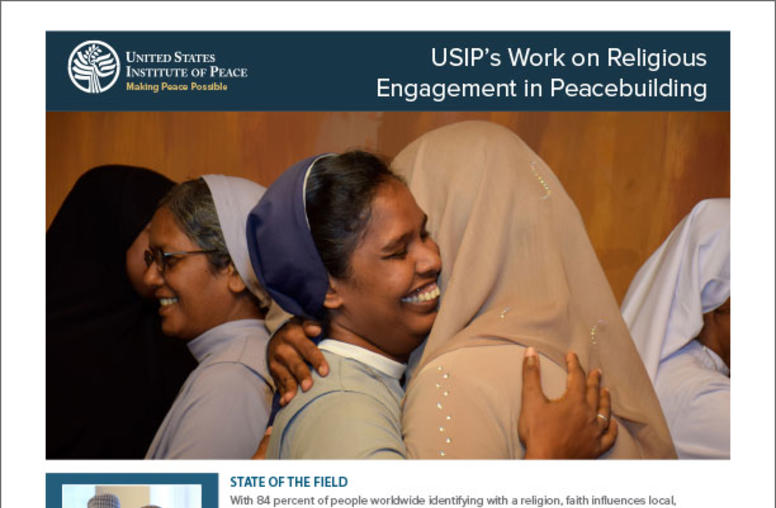Double Alienation and Muslim Youth in Europe
From the controversy raging in London over Muslim women wearing the niqab to the upsurge in violent crime in Paris, Muslims in Europe are at the center of a storm of disagreement. Although many Muslim youth are comfortable as Muslim and European, others feel estranged from society.
From the controversy raging in London over Muslim women wearing the niqab to the upsurge in violent crime in Paris, Muslims in Europe are at the center of a storm of disagreement. Although many Muslim youth are comfortable as Muslim and European, others feel estranged from society. A tiny minority of these youth are drawn to violence, in part as a solution to their alienation. USIP’s Muslim World Initiative helped sponsor a conference hosted by the British organization Wilton Park that discussed a wide variety of problems confronting Muslim youth in Europe. A theme that ran through the conference was how to combat the alienation of Muslim youth and encourage responsible citizenship. The conference brought together a wide range of Muslims, scholars and government representatives from countries around the world.
History of Muslims in Europe
Muslim immigrants were originally welcomed in Europe as vital contributors to the workforce. Muslims were encouraged to immigrate to countries such as Austria, Denmark, Germany, Luxembourg, Norway, Sweden, and Switzerland due to the labor shortage precipitated by World War II. Some also immigrated to European countries such as Belgium, France, the Netherlands and the UK in the 1960s and 1970s from former colonies. Starting in the 1970s, countries such as Ireland, Italy, Greece, Portugal and Spain witnessed an increase in the number of immigrants, including Muslims.
Muslims residing in these countries are not homogenous, but rather come from different national origins and religious backgrounds. Accurate figures are difficult to obtain due to lack of data based on religion; in France, for example, it is official policy not to collect such data. Estimates are that 15 to 20 million Muslims live in Europe, making up four to five percent of its total population. France has the largest proportion of Muslims (seven to ten percent of its total population), followed by the Netherlands, Germany, Denmark, Sweden, the UK, and Italy.1 Some countries have large subgroups of Muslims from particular communities, although the largest sub-groups do not always comprise the majority of Muslims in a given country. The largest subgroups of French Muslims come from Morocco and Algeria, along with many from Tunisia and Turkey. The UK’s largest sub-group of Muslims comes from Pakistan.
The Struggle for Identity among Muslim Youth in Europe
Many of the Muslims currently in Europe are descendents of immigrants who identify themselves by their country of residence. Such Muslims were born and raised as European citizens, and speak European languages as their mother tongue. For example, a British Muslim expert at the Wilton Park conference reported that 70 percent of Muslims in Britain identify themselves as "British."
The vast majority of Muslim youth in Europe want what most youth want: to fit in, even if they wish to retain religious traditions. They feel the most strongly tied to the countries in which they live rather than ancestral homelands, despite visits to relatives in other countries or marriages to people from abroad. Most Muslim youth do not stand out from their non-Muslim peers. Often, discussions about whether or not Muslim youth ‘fit in’ and ‘identify as European’ focus on small minorities within Muslim communities. For example, the controversy in France over whether headscarves should be allowed in public centered around only an estimated 1,500 Muslim youth and adults who wear headscarves, out of an approximate population of seven million Muslims in France.
Despite a desire for acceptance, Muslim youth in Europe often have difficulties navigating the amorphous terrain of identity. Many Muslim youth are comfortable with multiple identities and are able to negotiate between the more conservative world of their parents and the secular world outside the home. These youth pick and choose what they appreciate and what they criticize from both worlds. Unfortunately, they sometimes feel forced to choose only one identity.2
Lack of acceptance for their particular identity can lead Muslim youth in Europe to feel alienated from both non-Muslim and Muslim communities. They often feel that European communities discriminate against them. Muslim communities can also increase the alienation of youth by being too fragmented to offer positive role models to Muslim youth.
Alienation from non-Muslim European Communities
Muslim youth see discrimination in social, religious, and political spheres of life. In the social sphere, resource disparity in education particularly hurts Muslim youth, and is considered a form of discrimination. Although countries such as the UK, France, the Netherlands, and Sweden have tried to address this problem by allocating extra funding to neighborhoods with a high proportion of immigrant children, resource disparities continue to present serious problems.3 For example, protests by teachers and students erupted in France in the late 1990s due to lack of funds, salaries, infrastructure and teachers.4
Outside of the school system, Muslim youth see job discrimination as prevalent. France provides an oft-evoked example. Jean François Amadieu, researcher at Le Centre d'Etudes et de Recherches sur la Gestion des Organisations et des Relations Sociales (C.E.R.G.O.R.S.) disseminated the results of a study that handed out identical resumes with differing names to various businesses in the May 2004 publication of L'Observatoire des discriminations. Companies responded to resumes with Arabic-sounding names five times less often than resumes without such names. Many Muslim youth feel that Islam is singled out for discrimination and held to a different standard than other religions. These youth cite examples of Islam being attacked in newspapers and other forms of public discourse, while other religions with similar practices are not attacked or attacked with less vehemence. A conference participant noted that Muslims are criticized because they lack female preachers. Yet the Catholic church does not support female preachers either and, although it faces criticism, many Muslim youth think that it does not face as much criticism as Islam.
Muslim youth also see discrimination in security and civil-liberty related matters. Many Muslims feel that they are unfairly held to standards to which no other group is held: Muslims will be stopped at airport security checkpoints, have restricted access to foreign visas, and have restricted privacy at a disproportionate rate (by population) compared to non-Muslims. These acts are seen as unfair curtailments of civil liberties that are aimed specifically at Muslims, despite the fact that, like people from other religions, the vast majority of Muslims are not involved in terrorism. Muslim youth often react to perceived discrimination by becoming alienated from society.
Alienation Within Muslim Communities
Muslim youth, in addition to feeling the pressures of external alienation, often have no clear role models or authority figures to follow within their community. Lack of structure in terms of religious and secular organizations, as well as pressure from within families, can lead to the alienation of Muslim youth.
Muslims in Europe are rarely unified by authority structures transferred from their countries of origin. Since Muslims come from many different countries, their communities in Europe are often segregated rather than unified according to national origin. Even within a country of origin, Muslims adhere to different "schools" of religious traditions, leading to a lack of religious unity. In addition, Sunni Islam has no clear hierarchy even within a given religious tradition.
Since no formal hierarchy binds Sunni Muslims, anyone who has studied the Quran extensively can become an imam, and his (or, in some cases, her) authority depends on the number and strength of his supporters. Usually, imams learn from other imams in Middle Eastern schools. These imams, although currently coming under stricter scrutiny in the UK particularly, have previously taught whatever they desired. Many of them, newcomers to Europe, never learned European languages or tried to understand the cultures in which they lived and only taught the concepts they had learned in the Middle East. For example, in France 75 percent of the 1,200 clerics are not from France and a third of them do not speak French.5 This impairs their ability to help Muslim youth navigate life as Europeans and as Muslims, making it easier for Muslim youth to feel alienated.
Muslim youth also feel underrepresented in secular venues. In terms of national politics, European countries differ in their rates of political representation by Muslims. In the UK, political representation is comparatively high, while Germany’s strict naturalization laws precluded political participation until recently. Spain, Italy, and France have varying, but low, rates of political representation.6 Conference participants suggested that a lack of knowledge about how to influence the political process as well as internal fragmentation may particularly explain the difficulty Muslims face as they seek to integrate into the landscape of secular organizations. Muslims may have less expertise when it comes to running political campaigns and striving for elected positions. Also, community organizations founded by Muslims fight with each other for limited funding and prestige. For example, difficulties in building new mosques in some areas currently stems more from intra-communal fighting than from external rejection from planning authorities.7 British Muslims in particular complained about the lack of intra-communal discourse, since many organizations do not talk to each other directly. Often they only meet when the British government convenes Muslim organizations to hear their perspectives. This lack of internal cohesion and advocacy skills lead Muslim youth to feel that their issues of concern are not being heard.
Parental pressure can lead Muslim youth to feel alienated because some parents may only accept one option of identity for their children. If parents try to force their children to behave in any particular way, their children may react by hiding their actions, thus cutting themselves off from the bonds of supportive parents. For example, in Beeston, UK, Pakistani youth say they lead parallel lives: they are Westerners until they come home from school, and then Kashmiris at home. When parents fail to give younger Muslims freedom to openly express themselves or take active political and religious roles, they do so secretly.8 For youth who feel more comfortable in Europe than in ancestral countries, and yet are pressured to act in ways not accepted by their European peers, they feel isolated and alienated from both European societies and internal communities.
Recommendations to Reduce Alienation
Conference participants suggested that Muslim communities build strong institutions that can show Muslim youth how to express their identities positively and non-violently. Some organizations where Muslim youth can receive advice and connect with peers struggling to find their place in European society have already formed – The Muslim Youth Helpline was formed by a young British Muslim woman who gives advice to other Muslim youth; the Emel magazine publishes fashionable articles friendly to a conservative audience involved in European culture; and the Digital Halal Network’s "The Muslim Blog" in Denmark holds open forums for Muslim youth to discuss relevant issues of the day. These burgeoning communities are starting to help Muslim youth, but their efforts could be broadened to reach more people.
Muslim youth can also create programs on issues of concern that cross religious groups. British Muslim participants suggested that Muslim youth work with other UK youth who are against the war in Iraq in lobbying efforts. Such cross-religious efforts will make Muslim youth feel that they are constructively engaged in influencing policy and part of a larger European community. An existing model is the French organization Ni Putes ni Soumises ("Neither Prostitutes Nor Submissives") comprised of Muslim and non-Muslim girls from Parisian suburbs who promote awareness of physical and sexual violence against girls.
Yet non-youth oriented Muslim organizations, as well as the state, could also be involved in the lives of Muslim youth. Muslim organizations could reach out to youth through schools and form mentoring relationships. Governments could teach classes through mosque systems. As a German Muslim woman pointed out at the conference, 60 out of 83 mosques and prayer rooms in Berlin teach classes, so a network is already in place for reaching out to Muslim youth.
To alleviate perceptions of discrimination by Muslim youth, participants advised governments to continue to reduce inequality in social services such as school systems and to strictly enforce laws against discrimination. However, many of the causes of alienation could be addressed merely through more inclusive phrasing. Public discourse, whether laudatory or critical, should not hold Muslims in a category separate from the rest of society. For example, critiques of religious values that are espoused by multiple religions need not only target Islam. Condemnations of terrorism can acknowledge all the victims of terror, including Muslims. After the Madrid bombings, the president of Spain utilized inclusive phrasing, carefully mentioning all residents of Spain as victims of terrorists. Spanish Muslims showed their appreciation through a sharp spike in cooperation with the government on security issues.
Europeans, both Muslim and non-Muslim, must help youth feel accepted by their communities. Only then can Muslim youth successfully maintain a distinctive culture and religion while participating as European citizens.
Notes
1. Leiken, Robert S. "Europe’s Angry Muslims." Foreign Affairs. July/August 2005.
2. Fulat, Shareefa. Director of Muslim Youth Helpline and conference participant. Cited with permission.
3. Daun, Holger and Reza Arjmand. "Education in Europe." Review of Education 51:403–426 2005.
4. Keaton, Trica. "Arrogant Assimilationism." Anthropology and Education Quarterly. Vol. 36, No. 4 2005 pp. 405-423.
5. "Big Dominique and his struggle against the Islamists." The Economist. December 18, 2004. For a similar case in Bradford, also see See McLoughlin, Sean. "Mosques and the Public Space: Conflict and Cooperation in Bradford." Journal of Ethnic and Migration Studies. Vol. 31, No. 6, November 2005, pp. 1045-1066.
6. Cesari, Jocelyn. "Mosque Conflicts in European Cities." Journal of Ethnic and Migration Studies. Vol. 31, No. 6, November 2005. pp. 1015 2005.
7. ibid
8. Careel, Severin. "Anger and sorrow on the streets of Beeston." The Independent. July 17th 2005.
This USIPeace Briefing was written by Adi Greif, former guest scholar in the Center for Conflict Analysis and Prevention at the U.S. Institute of Peace. The views expressed here are not necessarily those of the Institute, which does not advocate specific policies.
The United States Institute of Peace is an independent, nonpartisan institution established and funded by Congress. Its goals are to help prevent and resolve violent international conflicts, promote post-conflict stability and development, and increase conflict management capacity, tools, and intellectual capital worldwide. The Institute does this by empowering others with knowledge, skills, and resources, as well as by directly engaging in peacebuilding efforts around the globe.



